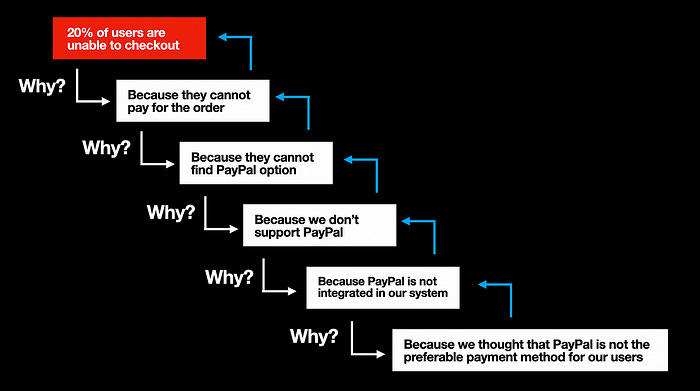Understanding how to talk with executives is a required design skill
How to effectively communicate with the person who signs your paycheck

“If an executive pulls out a phone during your meeting, you’ve lost them.” A Director of UX told me, speaking about his experiences.
I’ve recently been speaking with several design leaders for an upcoming white paper on how design should approach metrics.
Part of that conversation always revolves around a single question: “How do we get executives to care about design?”
It’s a common roadblock designers face, but it’s not just a challenge for Directors and Heads of UX. It’s something that even mid-level Designers have to tackle nowadays, as there’s a significant focus on demonstrating business impact.
You might have a brilliant idea, but if you cannot communicate it to the people who make decisions, it’s very likely to get rejected and for you to get ignored.
However, the problem is that many designers do not understand what executives want and need from UX. Here’s what I’ve learned, talking with design leaders.
It’s not a power imbalance: it’s an attention imbalance
The most common problem designers face with executives is the same issue they encounter with daily meetings.
Have you ever been sitting awkwardly in a meeting that devolves into a one-on-one conversation?
The Product Manager and Engineering are talking about some specifics to a project, and you’re just sitting there awkwardly checking e-mail and waiting for the meeting to finish.
That kills meetings with executives.
Executives are busy and often have a dozen things that they ‘should’ be doing at once. Sometimes, they attend meetings without knowing why they need to be there, only that they are expected to be there.
That’s why their attention is one of the most valuable things in the room. If the conversation seems like it doesn’t involve them, they’ll pull out their phones, check their e-mail, and then you’ve lost them.
Therefore, it’s crucial to redirect other conversations to ensure that you don’t lose the executive's attention. It doesn’t mean that you should ignore the rest of your team.
It simply means that it will be far easier to ‘catch up’ with them after the meeting rather than with an executive.
One of the easiest ways to keep their attention is to keep your presentation concise and to the point. Keeping executives focused for a 60-minute meeting is a monumental task, especially when involving a broader audience.
That’s not even considering that sometimes they might not be able to stay on for the entire 60 minutes.
As a result, I often advise my students to have a 5-minute story and expand as needed. That way, the length of your presentation will not risk losing their attention.
Another thing to do is to speak in terms they understand.
Executives don’t care about the number of clicks: scale your metrics
Most designers encounter issues with presenting because of a single reason: they explain things in UX terms instead of in terms that their audience understands.
For example, if a re-design of a product saved a couple of clicks, or even if the time to completion improved, executives don’t know (and don’t care) about what that means.
What designers often need to do is to think more about metrics that scale. One of the most effective ways to do this is the “Five Whys” method (link). This method doesn’t just help us zoom into the root cause: it can help us see the larger picture.
For example, imagine we started with the micro result: “Users click less with the re-design to create an account.”
We might use the Five Whys like this to zoom out into a result that matters:
Users click less with the re-design to create an account
Why does this matter? Because it’s easier for users to create a new account
Why does this matter? Now, more users who used to check out as guests, might be willing to create an account
Why does this matter? Our user sign-ups are likely to increase as a result of this change.
While this isn’t a perfect translation for some executives (you often need to get to either ‘revenue’ or ‘cost-savings’ for many executives), this can help you talk in ways that these decision-makers will understand.
Lastly, one of the most effective skills to learn, especially if you have Data, is Data Visualization.
Indirectly presenting? Lean into data visualization
One of the most common situations for mid-level designers is that executives might not see them but instead their ideas.
For example, you could convince your Product Manager of a great idea during one of their meetings, but they need to escalate it to get approval. As a result, they will bring it up with executives at their standing meeting.
How can you ensure that your ideas don’t get misinterpreted by someone else speaking and that it’s presented clearly? Data Visualization is often the best way.
Executives love shortcuts that summarize information. That’s why the one-page ‘executive summary’ is often at the front of reports that they read.
That’s why many of them also love dashboards, which quickly summarize the company's overall health and performance.
If you can visualize the problem and clearly identify where things are going wrong (and why it needs to change), that can save you the effort of training your PM to present, explain the context, and answer questions exactly as you have.
Make it easy enough to understand what you want to highlight, even when you’re not in the room, and you’d be surprised how much that makes a difference.
Talking with the business is increasingly becoming a part of design
Learning to communicate effectively with business professionals, especially executives, is one of the most critical aspects of advancing your design career.
I was fortunate enough to have an analogy in my career, working with doctors, that helped me understand how to communicate with busy professionals who have limited attention, such as executives.
But in 2025, you cannot be the ‘best-kept secret’ in the company and still expect to have both influence and a job. You need to not only show the strategic value of design. You need to help executives make the right decisions.
So, if you want to make a difference and are struggling right now, consider what you know (and what you need to learn) about decision-makers.
Understanding what they want from UX and the easiest way to deliver it to them can be a critical step in not only creating better products but also gaining approval for your ideas.
Kai Wong is a Senior Product Designer and Data and Design newsletter writer. He teaches a course, The Strategic Designer, that helps designers communicate their value and get buy-in for ideas.





